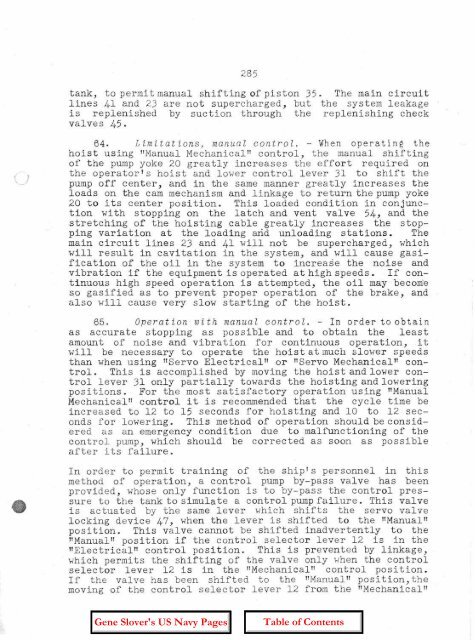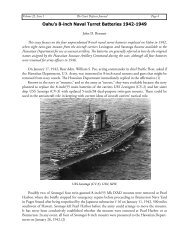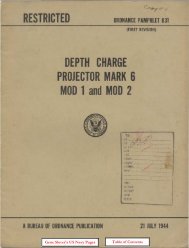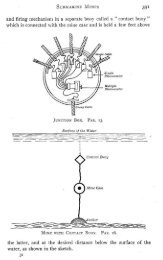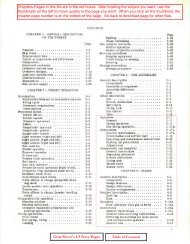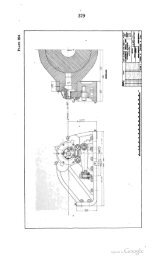OP-755 Part 2 Pages 197-401 - Personal Page of GENE SLOVER
OP-755 Part 2 Pages 197-401 - Personal Page of GENE SLOVER
OP-755 Part 2 Pages 197-401 - Personal Page of GENE SLOVER
You also want an ePaper? Increase the reach of your titles
YUMPU automatically turns print PDFs into web optimized ePapers that Google loves.
\ J<br />
285<br />
tank, to permit manual shifting <strong>of</strong> piston 35. The main circuit<br />
lines 41 and 23 are not supercharged, but the system leakage<br />
is replenished by suction through the replenishing check<br />
valves 45.<br />
64. Limitations) manual control. - When operating the<br />
hoist using "Manual Mechanical" control, the manual shifting<br />
<strong>of</strong> the pump yoke 20 greatly increases the effort required on<br />
the opera tor I s hoist and lower control lever 31 to shift the<br />
pump <strong>of</strong>f center, and in the same manner greatly increases the<br />
loads on the cam mechanism and linkage to return the pump yoke<br />
20 to its center position. This loaded condition in conjunction<br />
with stopping on the latch and vent valve 54, and the<br />
stretching <strong>of</strong> the hoisting cable greatly increases the stopping<br />
variation at the loading arid unloading stations. The<br />
main circuit lines 23 and 41 will not be supercharged, which<br />
will result in cavitation in the system, and will cause gasification<br />
<strong>of</strong> the oil in the system to increase the noise and<br />
vibration if the equipment is operated at high speeds. If continuous<br />
high speed operation is attempted, the oil may become<br />
so gasified as to prevent proper operation <strong>of</strong> the brake, and<br />
also will cause very slow starting <strong>of</strong> the hoist.<br />
65. Operation with manual control. - In order to obtain<br />
as accurate stopping as possible and to obtain the least<br />
amount <strong>of</strong> noise and vibration for continuous operation, it<br />
will be necessary to operate the hoist at much slower speeds<br />
than when using !lServo Electrical" or "Servo Mechanical" control.<br />
This is accomplished by moving the hoist and lower control<br />
lever 31 only partially towards the hoisting and lowering<br />
positions. For the most satisfactory operation using "Manual<br />
Mechanical" control it is recommended that the cycle time be<br />
increased to 12 to 15 seconds for hoisting and 10 to 12 seconds<br />
for lowering. This method <strong>of</strong> operation should be considered<br />
as an emergency condition due to malfunctioning <strong>of</strong> the<br />
control pump, which should be corrected as soon as possible<br />
after its failure.<br />
In order to permit training <strong>of</strong> the ship I s personnel in this<br />
method <strong>of</strong> operation, a control pump by-pass valve has been<br />
provided, whose only function is to by-pass the control pressure<br />
to the tank to simula te a control pumpfailure. This valve<br />
is actuated by the same lever which shifts the servo valve<br />
locking device 47, when the lever is shifted to the "Manual"<br />
position. This valve cannot be shifted inadvertently to the<br />
"Manual" position if the control selector lever 12 is in the<br />
"Electrical" control position. This is prevented by linkage,<br />
which permits the shifting <strong>of</strong> the valve only when the control<br />
selector lever 12 is in the "Mechanical" control position.<br />
If the valve has been shifted to the "Hanua l.'' position, the<br />
moving <strong>of</strong> the control selector lever 12 from the TlMechanical"


